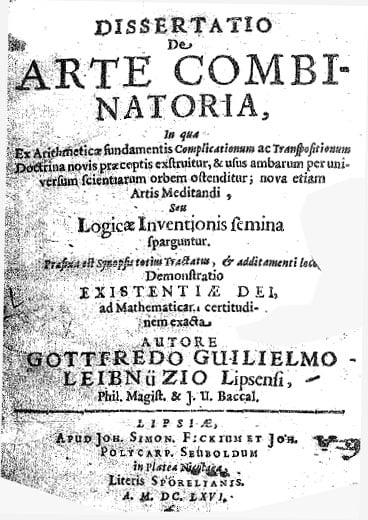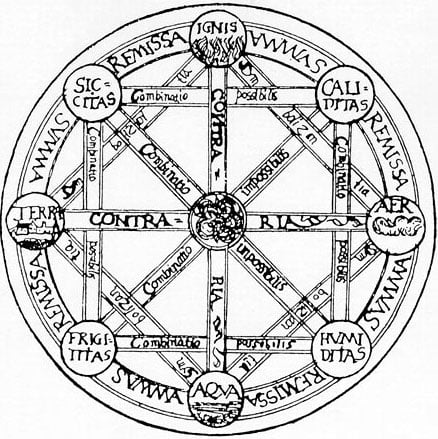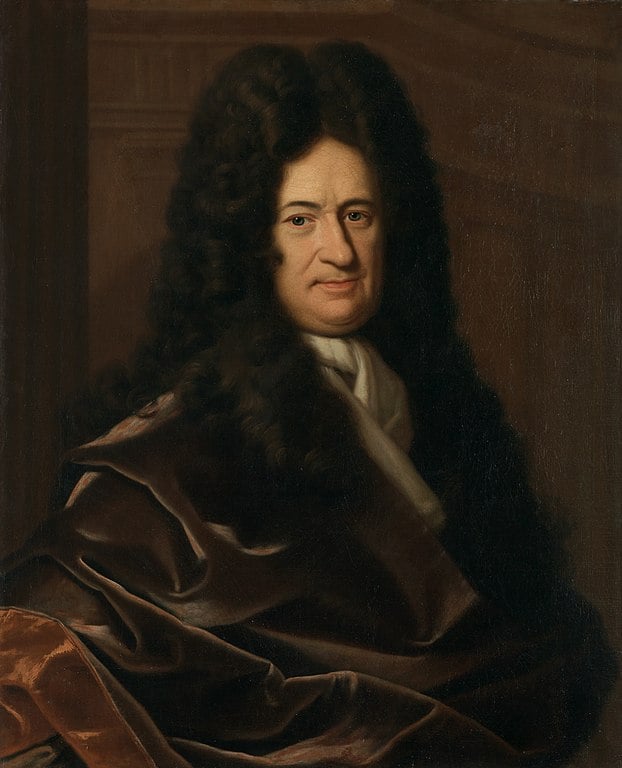
Gottfried Leibniz
The great German polymath Gottfried Leibniz (see biography of Leibniz) was one of the first men (after Ramon Llull and almost at the same time with Athanasius Kircher), who dreamed of a logical (thinking) device. We have to mention also the fact, that Leibniz created the first mechanical calculator, suitable not only for addition and subtraction, but for multiplication also — the Stepped Reckoner. But being an authentic genius and extremely powerful intellect, Leibniz made a huge step forward.

Leibniz Writes His First Book
In 1666 Leibniz published his first book (see the upper image of the title page), also his habilitation thesis in philosophy, Dissertatio De Arte Combinatoria (On the Art of Combinations), partly inspired by the Ars Magna of Ramon Llull (Leibniz was still a teenager when he encountered the works of Ramon Lull). Though the design Leibniz places at the front of his book (see the lower figure) appears to be a very simple and even trivial diagram, compared to the copperplates of Kircher’s books, the entire text that follows speaks a new and different language. Leibniz was only 20, but he analyzed as an advanced mathematician the potential power and limits of the art of combination.

In contrast with Llull and Kircher, Leibniz was not at all interested in any esoteric applications of this method, but rather in a way of reproducing the totality of the universe within one science. After reading his very famous treatise on the monads (Monadology from 1714) (monads are something like atoms, situated in the metaphysical realm) as a model for the art of combination, his new, radical perspective is at once comprehensible.
In 1674 Leibniz described a machine for solving algebraic equations. A year later, he wrote comparing logical reasoning to a mechanism, thus pointing to the goal of reducing reasoning to a kind of calculation and of ultimately building a machine, capable of performing such calculations.
The Philosopher’s Program was Ambitious
There is a letter written by Leibniz to Johann Friedrich, Duke of Hanover, in April 1679, which offers the whole ambitious program of the philosopher. In that letter, we find initially a confession about the source of the method of combination. But then Leibniz starts to criticize Llull and Kircher because, in his view, they did not go far enough in using this art of combination. Regarding his own idea of its use, he says:
“My invention contains the application of all reason, a judgment in each controversy, an analysis of all notions, a valuation of probability, a compass for navigating over the ocean of our experiences, an inventory of all things, a table of all thoughts, a microscope with which to prove the phenomena of the present and a telescope with which to preview those of the future, a general possibility to calculate everything. My invention is an innocent magic, a non-chimerical Cabbala, a writing, which everyone can read and which everyone can very easily learn…”
Quite a pathetic proclamation, but that was the style of the great philosopher! Leibniz apparently believed that he had invented a general problem-solver, like those in the computer sciences have always dreamed of. But of course, his whole super-ambitious program was not to be realized. Only some aspects of that proclamation were really transposed into useful applications. At first, Leibniz made a few essential steps toward the calculation of probability, which is obviously a very important problem for all so-called expert systems, and artificial intelligence in general. He then attempted to transcribe the whole art of combination into a system of formulas because he wanted to calculate every single part of the process, each step, and each result of an interval. Thus he used consequently his mathematical skills to produce a new kind of combination by transposing meanings into figures and values.
Leibniz Refines the Binary System
Even more — Leibniz was also one of the first men who realized the importance of the binary system (of course, he is not the inventor of the binary system. Pingala, an otherwise-obscure Indian author, wrote about 300 B.C. the Chandahsastra, or Science of Meters. In his treatise, he uses a binary logic system (short-long, in this case, rather than 0-1) to explore meter in poetry.) Leibniz discovered that computing processes can be done much easier with binary number coding (in his treatises De progressione Dyadica, 15th March 1679 and Explication de l’Arithmetique Binaire, 1703). In these clear and lucid treatises (the lower figure shows the second page of the original manuscript “De Progressione Dyadica”), Leibniz analyzed the possibilities of the binary system and, demonstrated its four fundamental operations of calculation — addition, subtraction, multiplication, and division — he expressed the conviction that one day in future the machines would use this system.

Though hard to believe, in his 3-pages treatise De progressione Dyadica, Leibniz even outlines a calculating machine that works via the binary system: a machine without wheels or cylinders — just using balls, holes, sticks and channels for the transport of the balls — This [binary] calculus could be implemented by a machine. The following method would certainly be very easy to implement. [A machine with] holes, which can be opened and closed. They are to be open at those places that correspond to a 1 and remain closed at those that correspond to a 0. Through the opened gates small cubes or marbles are to fall into channels, through the others nothing to fall. It [the gate array] is to be shifted from column to column as required for the multiplication. The channels should represent the columns, and no ball should be able to get from one channel to another except when the machine is put into motion. Then all the marbles run into the next channel, and whenever one falls into an open hole it is removed. Because it can be arranged that two always come out together, and otherwise they should not come out.
Leibniz Reflects on His Works
In a note, written later in his life, when he was reflecting on his works, he remembered the old program of the universal art of combination:
I thought again about my early plan of a new language or writing-system of reason, which could serve as a communication tool for all different nations… If we had such an universal tool, we could discuss the problems of the metaphysical or the questions of ethics in the same way as the problems and questions of mathematics or geometry. That was my aim: Every misunderstanding should be nothing more than a miscalculation (…), easily corrected by the grammatical laws of that new language. Thus, in the case of a controversial discussion, two philosophers could sit down at a table and just calculating, like two mathematicians, they could say, ‘Let us check it up …’
Binary Calculus is Developed
Another remarkable idea of Leibniz, announced in his February 1678, essay “Lingua Generalis”, was connected closely with his binary calculus ideas. Leibniz spoke for his lingua generalis or lingua universalis as a universal language, aiming it as a lexicon of characters upon which the user might perform calculations that would yield true propositions automatically, and as a side-effect developing binary calculus. Today it is believed that Leibniz, independently and at the same time, invented calculus along with Isaac Newton.
Leibniz was indeed a great inventor, in spite of not realizing his dream of inventing the general problem-solver. This was impossible with the knowledge and technology, available at his time. To my mind, if we have to appoint the two greatest persons in the history of computers, the first definitely will be Gottfried Leibniz, side by side with Charles Babbage
The image featured at the top of this post is ©Christoph Bernhard Francke, Public domain, via Wikimedia Commons – License / Original
